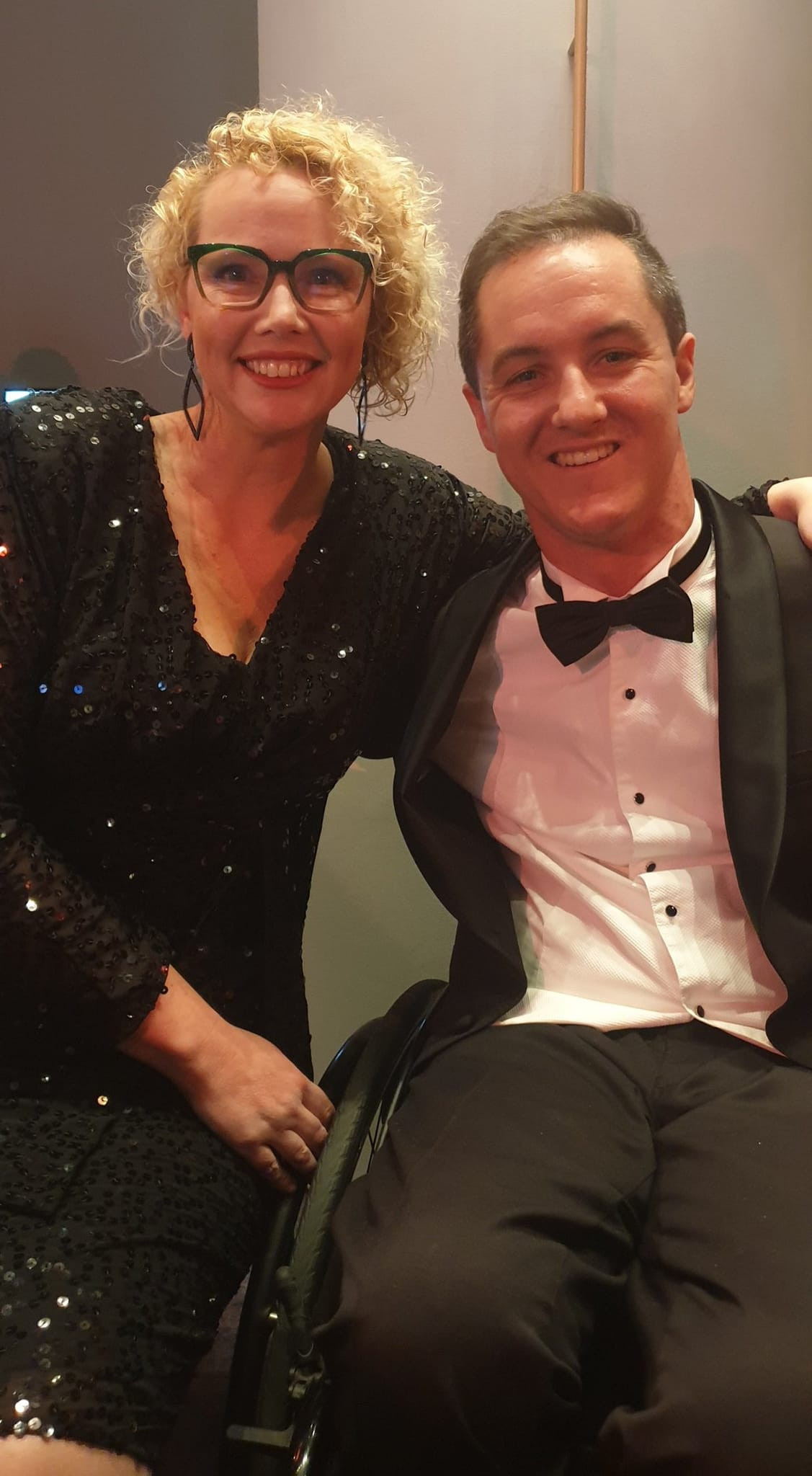
Charles Brice
ABC News Breakfast Reporter Charles Brice shares his story after a motorbike accident at just 19 left him a quadriplegic.
Having experienced life as disabled and non-disabled, Charles is passionate about educating and creating awareness about disability, in particular spinal cord injuries. He co-founded Wheel To Walk, an initiative which has raised more than $300,000 for research into spinal cord injuries by riding more than 600 kms on his handcycle.
Charles’ story
When I was 19-years-old I never thought about being a journalist. I wanted to be a pilot and was on my way to getting my pilot’s licence. I was offered a job to live and work on my mate’s family farm in Loxton and I jumped at the chance, resigning from my job in Adelaide, packing up everything and moving there the next day. I absolutely loved it. There were a lot of locals who I had not met and so a small group had decided to go for a casual motorbike ride on a Saturday morning together. I remember holding everyone up because the farm bike I had to ride wouldn’t start. We set off, stopping every 15 minutes or so to regroup. The farm bike I was riding was a bit slower so I was always the back of the pack, with everyone in front out of sight. As I came round a slight bend in the track there was a series of successive bumps. The front wheel dug into one of those bumps and sent me over the handlebars, landing head first on the soft sand.
Lying alone on the ground, I realised I couldn’t move. I was the only one in the group with a phone. I tried to reach into my pocket to call for help but I couldn’t. Only able to lift my head slightly, I could see my legs were at funny angles but other than that I didn’t have a scratch on me. It took about 30 minutes for someone to find me, but it felt like an eternity lying there, alone, scared, with a million thoughts racing through my head. When the guys came back and found me, I had to ask them to use the phone in my pocket to call for help.
I was taken to Loxton Hospital and then flown out to the Royal Adelaide Hospital that night where my family rushed to meet me. It was there I was told that I had shattered two vertebrae in my neck and completely severed my spinal cord. I can still remember being told that I was a quadriplegic and there was only a 5% chance that I would ever walk again. Heavily medicated and still in a bit of denial, that was the moment it became real for me. I had never imagined in my wildest dreams that I would ever hear those words from a Doctor.
Within hours Professor Brian Freeman operated on me to fuse my C5/C6 vertebrae. After my operation I lay unconscious for three weeks and was ventilated for nearly 2 months. I spent 52-days in the ICU, 21-days in the Spinal Ward at the RAH and then 14-months in rehab at Hampstead.
Rehabilitation
Transitioning to rehab was a big adjustment. In ICU you have one-to-one nursing which means there is someone with you all the time. Obviously, that is important in case you need something or there is an emergency, but it is also just comforting having someone there to keep you company. I was fortunate that I did have the support of my friends and family throughout my time in hospital, it would have made such a difference to my headspace if I didn’t have that.
Rehab was about working with what you’ve got. I was pretty realistic. At that point I couldn’t even lift my arm to scratch my nose so I wasn’t thinking I was going to be walking again. It was a lot of arm exercises and balancing and combining the two. For a long period of time it felt very mundane and not productive at all. I went from being a sporty 19-year-old, to sitting on the edge of a bed trying to hit a balloon with my arms. It was like a smack in the face. Back in 2010 the world was much less accepting of people with disabilities. I didn’t know anyone at the time in a wheelchair. I was embarrassed, I didn’t feel like myself and I went through a real identity crisis. Fourteen months is a long time, and I was able to regain quite a bit of movement in that time, until I was eventually able to push myself around in a manual chair. That was a huge positive milestone for me. I found an electric wheelchair really limits your options and independence. Getting in a manual chair and being able to move myself around independently was a big deal.
What have you found helpful throughout your journey?
What really helped me was being around other people in a chair. That’s one way I learned how to do various things, as you can sit back and watch how they do it. I played wheelchair rugby for a couple of years, and I distinctly remember a particular trip to Bali. This was around 4-years after my injury, and I was still using adaptive tools to be able to feed myself and I thought that’s what everyone did. Day one it gets to lunchtime and I look around and no-one else is using them. So I was like, well I’m the youngest person here there is no way I’m going to be the only person using them. Suffice to say I didn’t eat very much that first day. But I was able to sit and subtly watch how other people did it. That was a game-changer. A lot of finding out what works is just trial and error. I never joined any specific support groups but I think that is just because I was around others through sport and things like that.
I don’t play rugby anymore, but I did take up hand cycling and was doing that competitively. I have done endurance rides with the purpose of fundraising and that’s been really successful. We’ve been able to raise more than $300,000 for spinal cord injury research. Exercise is key to so many things, particularly your mental health, and I found that helped me in spades.
What are some things you wish people were more aware of about spinal cord injury?
How much time do you have! It’s through no fault of their own, at one point in time I was the same. The first time I learned about spinal injury was the day I found out I had one. To this day I still get a lot of people that think that a quadriplegic is someone that can’t move any part of their body. There are also the hidden effects of spinal cord injury that no-one really knows about. The internal bodily functions, regulating body temperature things like that. These days, I would actually prefer to have some of those internal functions, or even just full use of my hands and arms over being able to walk again.
Then there are things around accessibility. Labelling shops as wheelchair accessible for instance when there is a 5cm step to the shop entrance. For some wheelchair users that would be ok, but for me and a lot of others it’s not. Also people often assume things are accessible when they’re not, and so then it just becomes a barrier to doing the things that anybody should have the opportunity to do. Shops are the biggest ones that stick out to me because you’re going into them all the time. I feel like it is getting better but I find that often the shop owner really does want to make it accessible, but either they don’t own the building or it’s a huge financial burden. So you understand the reasoning behind it but it is still very excluding.
Where did the idea of journalism come from?
Going through hospital and rehab the TV was pretty much on 24/7 and there were no streaming services back then so the news was always on. I developed quite a liking to it and it began to feel like something I could do physically. I knew I wanted to do TV journalism but at the time it didn’t seem like a possibility. I had never seen anyone with a wheelchair or disability on TV. But I thought well there has to be a first time for everything, and 11-years on I was fortunate enough to get in front of a camera for the first time. I really enjoy it and it’s great to have that exposure of disability on TV and for a national audience as well. Hopefully it can open up some doors and give hope to other people going through similar circumstances.
How are you feeling these days?
Tired! I have always been a bit of a morning person though. My first job out of school started at 5am and I’ve never had a 9-5 job which is great for me. I’m feeling very settled in my role and I love it so hopefully I’m able to keep doing it as long as I can.
Charles was an invited speaker to the NRF 2022 NeuroConnect Gala Dinner where he kindly shared his story, and is pictured below with MC and brain tumour survivor Allys Todd.

Learn about the spinal cord injury research currently being funded by your generous donotaiton here




